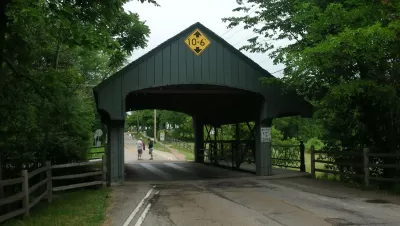Facing a shortfall of more than $1 million to maintain its roads, the Chicago suburb of Long Grove is looking to privatize nearly half of them by asking residents to pick up the tab. Residents are unhappy about the plan, but see few alternatives.

"Facing an annual funding gap of more than $1 million, Long Grove trustees have twice in recent months affirmed a plan that could privatize nearly half of the village's public roads — transferring the cost of upkeep and plowing to the residents in the process," reports Duaa Eldeib.
How did the affluent community get itself into this problem in the first place? A lack of property taxes, building permit revenues that were decimated by the recession, and "29 miles of public roads for a relatively small population of about 8,000," are seen as the primary contributing factors.
"Experts in public planning and municipal finance agree that Long Grove has hit upon an unusual potential solution to a commonplace problem," adds Eldeib. "They say other communities also struggling to make ends meet could follow suit as aging roads deteriorate and revenue streams dry up. Yet such plans could eat away at the public's trust in local leadership even as they mitigate public deficits, warned Joseph Schwieterman, a DePaul University transportation professor."
"It's going to create resentment that city hall has broken its contract to fix the roads, and that could lead to turmoil that tears at the social capital of a community," he said.
FULL STORY: Long Grove plan may pave way to privatize public roads

Study: Maui’s Plan to Convert Vacation Rentals to Long-Term Housing Could Cause Nearly $1 Billion Economic Loss
The plan would reduce visitor accommodation by 25,% resulting in 1,900 jobs lost.

North Texas Transit Leaders Tout Benefits of TOD for Growing Region
At a summit focused on transit-oriented development, policymakers discussed how North Texas’ expanded light rail system can serve as a tool for economic growth.

Why Should We Subsidize Public Transportation?
Many public transit agencies face financial stress due to rising costs, declining fare revenue, and declining subsidies. Transit advocates must provide a strong business case for increasing public transit funding.

How to Make US Trains Faster
Changes to boarding platforms and a switch to electric trains could improve U.S. passenger rail service without the added cost of high-speed rail.

Columbia’s Revitalized ‘Loop’ Is a Hub for Local Entrepreneurs
A focus on small businesses is helping a commercial corridor in Columbia, Missouri thrive.

Invasive Insect Threatens Minnesota’s Ash Forests
The Emerald Ash Borer is a rapidly spreading invasive pest threatening Minnesota’s ash trees, and homeowners are encouraged to plant diverse replacement species, avoid moving ash firewood, and monitor for signs of infestation.
Urban Design for Planners 1: Software Tools
This six-course series explores essential urban design concepts using open source software and equips planners with the tools they need to participate fully in the urban design process.
Planning for Universal Design
Learn the tools for implementing Universal Design in planning regulations.
City of Santa Clarita
Ascent Environmental
Institute for Housing and Urban Development Studies (IHS)
City of Grandview
Harvard GSD Executive Education
Toledo-Lucas County Plan Commissions
Salt Lake City
NYU Wagner Graduate School of Public Service





























